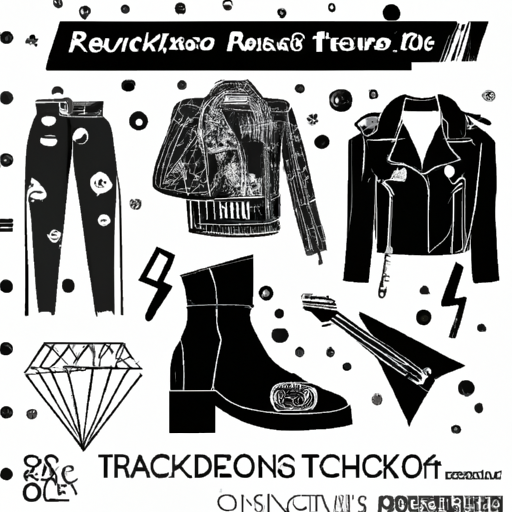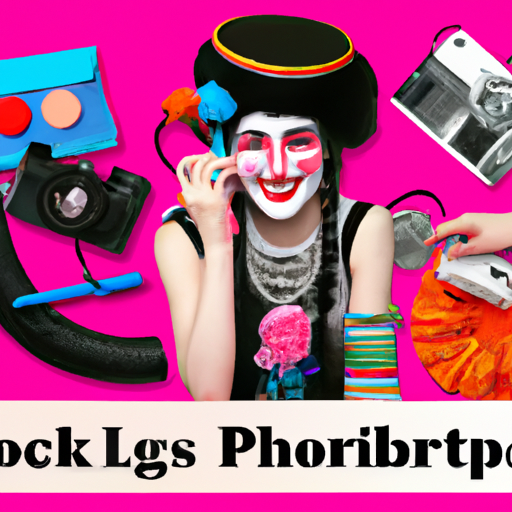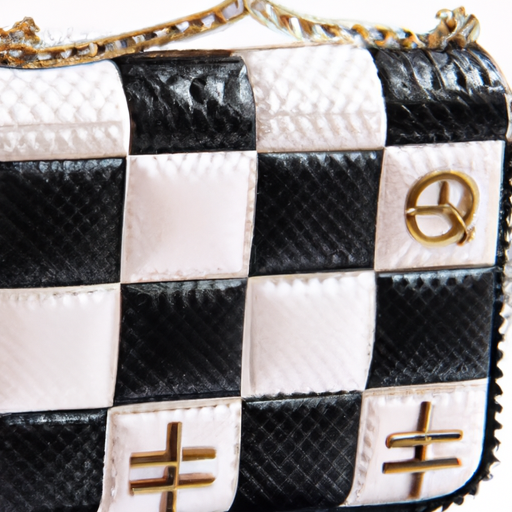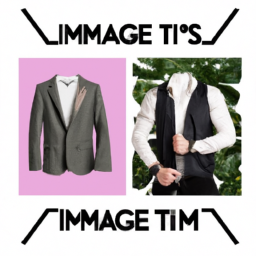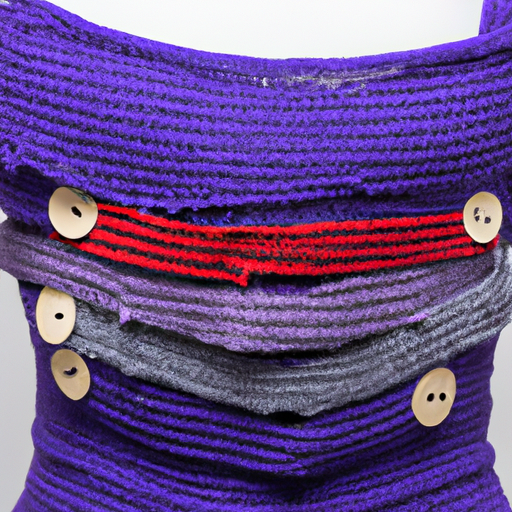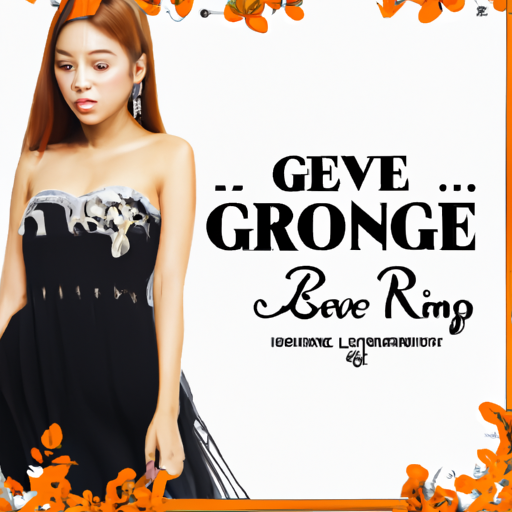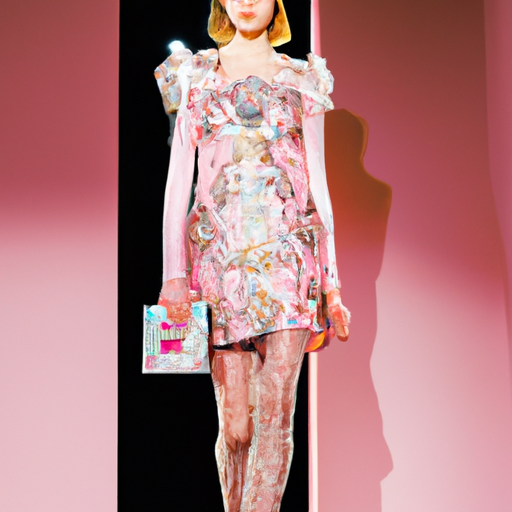Which Fashion Trends Were Inspired By Rock Music In The 1970s?
In the groovy era of the 1970s, rock music not only left an indelible mark on our playlists but also influenced the way we dressed. From the rebellious leather jackets to the flashy platform shoes, this article explores the iconic fashion trends that were born from the electrifying sounds of rock music. Whether it’s the flamboyant glam rock styles or the edgy punk attire, step into the time machine and discover the fashion revolution that rocked the world in the 1970s.
Table of Contents
Glam Rock
Glam Rock was a popular music genre in the 1970s that not only revolutionized the music industry but also left a lasting impact on fashion. Platform shoes, glitter, and sequins were key elements of this extravagant and flamboyant style.
Platform Shoes
One of the most iconic fashion trends associated with Glam Rock was the platform shoe. These shoes had thick elevated soles that ranged from a few inches to towering heights. They added both height and drama to any outfit, and were often adorned with glitter, sequins, or bold patterns. Platform shoes were a statement piece that perfectly complemented the flashy and attention-grabbing nature of Glam Rock music.
Glitter and Sequins
Glam Rock fashion was all about sparkle and shine, and there was no shortage of glitter and sequins. From head to toe, artists and fans embraced these dazzling embellishments. Glittery tops, sequined pants, and bedazzled accessories were common in Glam Rock fashion. The reflective nature of these materials brought the stage presence of the musicians to life, creating a visually striking and captivating experience.
Bold Makeup
Glam Rock musicians were known for their bold and theatrical makeup looks. Men and women alike embraced vibrant and striking makeup choices. Heavy eyeliner, bold eyeshadow, and colorful lipstick were all part of the signature Glam Rock aesthetic. The makeup emphasized the androgynous image that many Glam Rock artists portrayed, blurring the boundaries of gender norms and creating a unique and rebellious style.
Bohemian Style
The Bohemian style, also known as “Boho,” started to gain popularity in the 1960s and continued to influence fashion throughout the 1970s. It was a free-spirited and unconventional style that was heavily influenced by Rock music.
Flowy Dresses
Bohemian fashion celebrated a relaxed and carefree lifestyle, and flowy dresses were a staple of this style. These dresses were often made from lightweight and breathable fabrics such as cotton or chiffon, allowing for freedom of movement. Floral patterns, paisley prints, and earthy colors were commonly found in Bohemian dresses, further embodying the organic and natural feel of the style.
Bell Bottoms
The 1970s were known for their love of wide-legged pants, and bell bottoms were at the forefront of this trend. Bohemian fashion embraced the boho-chic look by pairing bell bottoms with flowy tops and accessories. These pants were tight-fitting around the thighs and then flared out from the knees down, creating a dramatic and retro silhouette.
Fringe and Embroidery
Fringe and embroidery were key elements in Bohemian fashion. Dresses, jackets, and accessories were adorned with intricate patterns, adding texture and visual interest to the garments. Fringe, in particular, was widely used to embellish bags, jackets, and skirts, giving them a fun and playful vibe. These details added to the overall bohemian aesthetic, adding a touch of whimsy and individuality.
Leather and Studs
Leather and studs were iconic elements of the rebellious and edgy fashion inspired by Rock music in the 1970s. This style was popularized by both Rock musicians and their die-hard fans, creating a fashion statement that exuded confidence and rebellion.
Leather Jackets
The leather jacket became a symbol of rock and roll during this era. It exuded a rugged and rebellious attitude that perfectly matched the edginess of the music. Leather jackets were often adorned with band patches, studs, and other embellishments to showcase personal style and loyalty to favorite bands. This iconic outerwear piece continues to be a staple in modern-day rock-inspired fashion.
Studded Accessories
Studded accessories played a significant role in both the Punk and Metalhead fashion scenes. Leather belts, bracelets, and chokers were commonly embellished with metal studs, adding a tough and edgy aesthetic to any outfit. These accessories were often paired with band t-shirts and ripped jeans, creating a cohesive and rebellious look that was synonymous with Rock music.
Motorcycle Boots
No rock-inspired outfit would be complete without a pair of Motorcycle boots. These sturdy and durable boots were not only practical for the rockers’ on-stage performances but also added a rebellious and tough edge to their overall look. Motorcycle boots were often made of leather and featured buckles, heavy soles, and chunky designs. They provided both style and comfort, making them a staple in Rock fashion.
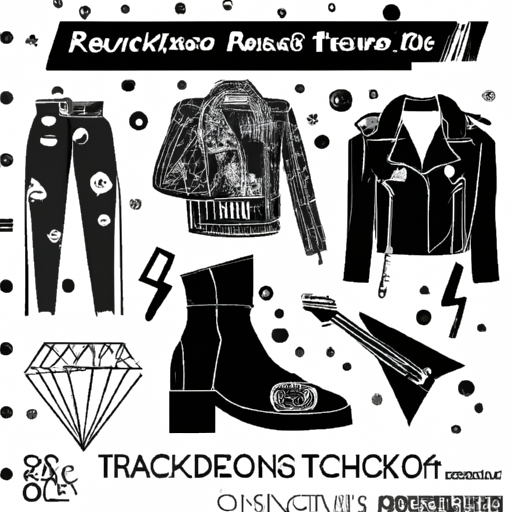
Headbanger Fashion
Headbanger Fashion emerged from the heavy metal music scene of the 1970s, creating a distinct and rebellious style that represented the hard-hitting sound and attitude of this genre.
Band T-Shirts
One of the most recognizable fashion trends associated with Headbanger Fashion is the band t-shirts. Fans proudly displayed their favorite rock bands by wearing t-shirts adorned with band logos, album covers, and tour merchandise. These t-shirts became a symbol of loyalty and served as a conversation starter among fellow rock enthusiasts.
Denim Jackets
Denim jackets were a staple in Headbanger Fashion. Whether adorned with band patches, painted artwork, or ripped and distressed, these jackets were a must-have item that perfectly encapsulated the raw and rebellious nature of heavy metal music. Denim jackets provided both style and a sense of camaraderie within the rock community.
Ripped Jeans
Ripped jeans were a rebellion against traditional fashion norms and played a prominent role in the Headbanger Fashion scene. Fans of heavy metal music embraced this rugged and distressed look by tearing their jeans, sometimes layering them with fishnet stockings or ripped tights underneath. Ripped jeans were the embodiment of the rebellious and non-conformist spirit of Rock music.
Androgynous Fashion
In the 1970s, Rock music challenged gender norms, and the androgynous fashion trend emerged. It blurred the lines between masculinity and femininity, creating a style that was both daring and liberating.
Gender-Neutral Clothing
Androgynous fashion embraced gender-neutral clothing, allowing individuals to express themselves freely without conforming to societal expectations. Men and women began to wear clothing traditionally associated with the opposite gender, such as tailored suits, oversized shirts, and wide-legged pants. This trend challenged the notion of what was considered “appropriate” for each gender, encouraging self-expression and breaking down barriers.
Platform Boots
Platform boots were a unisex trend that became synonymous with the androgynous style of the 1970s. These bold and statement-making shoes added height and attitude to any outfit while challenging traditional notions of gender-specific footwear. Platform boots provided a sense of empowerment and confidence, making them a popular choice among those who embraced the androgynous fashion movement.
Tailored Suits
Tailored suits became a powerful symbol of gender fluidity during this era. Rock musicians, such as David Bowie, embraced the androgynous style by wearing tailored suits with flamboyant patterns, vibrant colors, and exaggerated silhouettes. The suits were often paired with ruffled shirts, bowties, and accessories, creating a unique and distinct look that defied gender norms and pushed boundaries.
Punk Style
Punk fashion emerged as a rebellious and anti-establishment movement in the 1970s, influencing both music and fashion. With its bold and unconventional style, Punk fashion became a way for individuals to express their dissatisfaction with mainstream society.
Mohawks and Spikes
One of the most iconic features of Punk fashion was the extreme hairstyles. Mohawks, with their shaved sides and a strip of long hair running down the center, became a symbol of rebellion and non-conformity. The hair was often dyed in vibrant and unconventional colors, reflecting the punk movement’s rejection of societal norms. Additionally, spikes were frequently incorporated into hairstyles or accessories, adding an edgy and defiant element to the overall look.
Leather Pants
Leather pants were a staple in Punk fashion, representing the gritty and rebellious nature of the movement. Both men and women embraced this trend as a way to defy traditional fashion norms. Leather pants were often tight-fitting and worn with an attitude, creating a sense of toughness and rebellion that defined the Punk style.
Safety Pins
Safety pins were an essential element in Punk fashion and were used as functional accessories. Punks would use safety pins to create unique and edgy looks by attaching them to clothing, such as jackets, pants, or shirts. This DIY approach emphasized the anti-establishment ethos of the Punk movement and served as a way for individuals to express their creativity and individuality.
Metalhead Fashion
Metalhead Fashion emerged from the heavy metal and hard rock music scenes in the 1970s and became a recognizable style that continues to endure to this day. This fashion trend embraced a dark and edgy aesthetic that mirrored the heavy and aggressive sound of the music.
Black Band Merchandise
Metalhead Fashion was characterized by the widespread wearing of black band merchandise. Fans proudly displayed their love for their favorite bands by wearing t-shirts, hoodies, and accessories adorned with band logos, album covers, or tour art. The black clothing represented the darkness and intensity of the music, creating a sense of unity and identity within the metal community.
Denim Vests
Denim vests, also known as battle jackets, were a go-to fashion item for metalheads. These vests were often adorned with patches, pins, and band logos representing a personal collection of favorite bands and the wearer’s musical taste. Denim vests became a symbol of dedication and loyalty to the metal genre, showcasing the wearer’s involvement in the music community.
Chunky Boots
Chunky boots were a staple in Metalhead Fashion. These sturdy and heavy boots provided both style and practicality, as they were suitable for the energetic and powerful performances associated with heavy metal music. The platforms and thick soles added height, creating a dominating and intimidating presence. The footwear choice reflected the powerful and aggressive nature of the music, further solidifying Metalhead Fashion as a distinct and impactful style.
Disco Influence
Disco was a prominent music genre in the 1970s, famous for its upbeat and danceable tunes. The influence of Disco music extended beyond the dance floor and into fashion, creating a vibrant and flashy style that was synonymous with the era.
Bell Sleeve Tops
Bell sleeve tops were a fashion trend that gained popularity during the Disco era. These tops featured flared sleeves that widened from the elbow to the wrist, creating a playful and exaggerated silhouette. Bell sleeve tops often incorporated bright colors, bold patterns, and lightweight fabrics such as silk or chiffon, allowing for fluid movement and showcasing the disco-inspired rhythm.
Sequined Jumpsuits
Sequined jumpsuits were a staple in Disco fashion and quickly became an iconic symbol of the era. These one-piece garments were often form-fitting, featuring all-over sequin embellishments that caught and reflected the light, creating a dazzling effect on the dance floor. Sequined jumpsuits embodied the glamorous and extravagant nature of Disco, allowing individuals to shine and stand out in a crowd.
Wide-Legged Pants
Wide-legged pants were another Disco-inspired fashion trend that remained popular throughout the 1970s. These pants were loose-fitting around the hips and thighs and gradually flared out from the knees to the ankles, creating a flowing and effortless look. Wide-legged pants were often paired with platforms or high heels, elongating the silhouette and allowing individuals to showcase their dance moves.
Rockabilly Style
Rockabilly fashion emerged as a subculture in the 1950s, but it continued to have an influence on fashion throughout the 1970s. Inspired by early Rock and Roll and Rockabilly music, this style emphasized a vintage and retro aesthetic with a modern twist.
Polka Dot Dresses
Polka dot dresses were a quintessential component of Rockabilly fashion. These dresses often featured a fitted bodice, a cinched waist, and a full, flared skirt that created a feminine and hourglass silhouette. Polka dot patterns, typically in black and white or bold contrasting colors, added a playful and retro vibe to the dresses. Rockabilly enthusiasts embraced this timeless print and made it a staple in their wardrobes.
Cuffed Jeans
Cuffed jeans were a popular choice among Rockabilly fashion enthusiasts. Men and women would roll up the hems of their jeans to showcase their stylish footwear, such as saddle shoes or classic sneakers. The cuffed jeans added a touch of vintage nostalgia to the overall look and were often paired with polka dot tops, button-up shirts, or leather jackets to complete the Rockabilly aesthetic.
Red Lipstick
Bold and vibrant red lipstick played a significant role in Rockabilly fashion. Both men and women embraced this classic makeup choice, as it perfectly complemented the vintage and retro-inspired style. The red lipstick added a touch of glamour and sophistication, enhancing the overall appearance and capturing the timeless elegance associated with the Rockabilly era.
Grunge Fashion
Grunge fashion emerged in the late 1980s and early 1990s as a response to the commercialized and polished nature of mainstream music and fashion. However, its roots can be traced back to the rebellious and alternative fashion of the 1970s.
Flannel Shirts
Flannel shirts became synonymous with Grunge fashion, providing a signature look for both men and women. These oversized and often plaid-patterned shirts were worn unbuttoned or tied around the waist, creating a laid-back and nonchalant vibe. The flannel shirts represented the DIY and non-conformist spirit of the Grunge movement, as they were often thrifted or borrowed rather than purchased brand new.
Ripped Tights
Ripped tights were a common sight in Grunge fashion. Whether paired with dresses, oversized sweaters, or ripped jeans, the deliberately torn tights served as a counter to the polished and put-together fashion trends of the time. The distressed and edgy aesthetic of ripped tights perfectly embodied the raw and grungy nature of the music and culture, creating a style that was both rebellious and effortlessly cool.
Combat Boots
Combat boots were a staple footwear choice in Grunge fashion. These sturdy and utilitarian boots added a tough and edgy element to any outfit. Paired with ripped jeans, flannel shirts, or oversized sweaters, combat boots completed the Grunge look, providing both style and comfort. The footwear choice reflected the rebellious and non-conformist nature of the Grunge movement, consistently pushing against the mainstream fashion trends of the time.
In conclusion, the fashion trends influenced by rock music in the 1970s were diverse, rebellious, and truly iconic. From the extravagant and flamboyant style of Glam Rock to the laid-back and vintage-inspired Rockabilly fashion, each trend embodied the spirit and attitude of the music scenes that inspired them. Whether it was through the bold and theatrical makeup of Glam Rock or the rugged and edgy leather jackets of the Punk and Metalhead styles, rock music revolutionized fashion and allowed individuals to express their creativity, individuality, and rebellion against societal norms. These trends continue to inspire and influence fashion to this day, highlighting the enduring impact of rock music on the world of style and self-expression.
